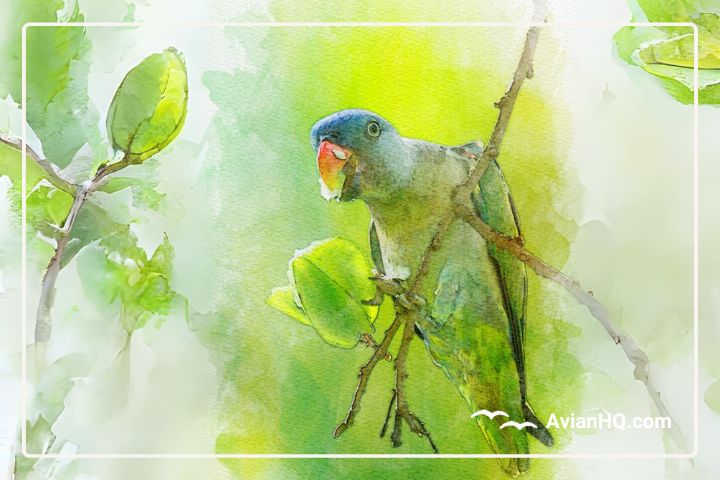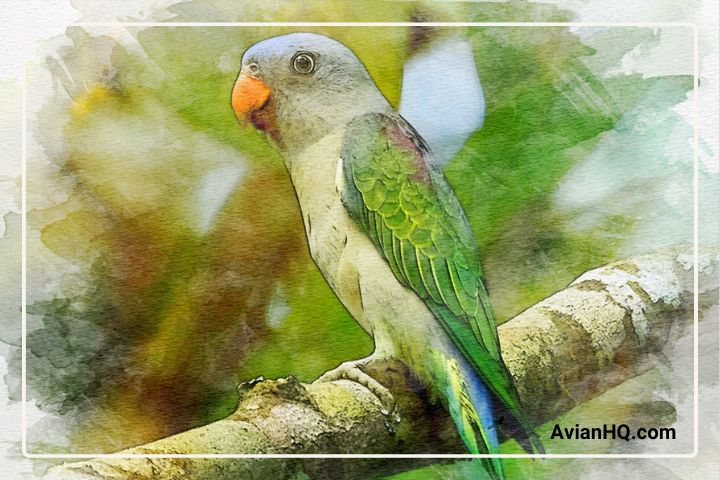Abbott’s Hanging Parrot (Psittinus abbotti)
The Abbott’s Hanging Parrot (also known as Simeulue parrot) is a small, vibrantly colored bird native to the islands of Indonesia. With its bright plumage and high-pitched squawking, this parrot is a characterful addition to its tropical habitat. Though the Abbott’s Hanging Parrot may be tiny, it makes up for its size with its impressive acrobatics and social, active nature.
You’ll find these parrots congregating in canopy treetops and fruit trees, clambering around with almost monkey-like agility. Their hook-tipped beaks give them an excellent grip as they hang upside down to feed. The Abbott’s Hanging Parrot is adept at cracking into seeds and nuts to get at the goodness inside.
While a beautiful bird, the Abbott’s Hanging Parrot does face some conservation threats. Habitat loss and capture for the pet trade impact populations. However, stable numbers in some protected areas provide hope for the future of this uniquely athletic and social parrot.
In this article, you’ll learn all about the Abbott’s Hanging Parrot’s distinctive looks, behaviors, and place in its environment. Along with appreciating this bird’s many charms, you’ll also learn about conservation efforts working to ensure this species continues to brighten Indonesian forests.
Physical Appearance
The Abbott’s Hanging parrot is a compact bird with a petite tail, measuring around 19 cm (7 inches). Its vibrant green plumage is complemented by a blue visage adorned with a green crest and a black band around its neck. It can be distinguished from the blue-rumped parrot due to its larger size, absence of gray feathers on its back and shoulders, lack of a blue hind part, the green head coloration in females instead of brown, and blue head coloring in males.
Like many parrots, the Abbott’s Hanging Parrot has zygodactyl toes – two point forward and two point back. This arrangement helps them easily grip branches. Their curved beak also has a small hook at the tip, further aiding their acrobatic movements in trees.
The young of this species hatch mostly naked, with just a light gray down. Juveniles start off with a pale green and gray coloration, eventually molting to the brighter adult plumage.
The Abbott’s Hanging Parrot’s vibrant feathers help it camouflage within the rainforest canopy. When at rest, the green allows them to blend into foliage. The red patch on the forehead becomes visible only when the parrot is active and moving about.
Habitat and Distribution
The Abbott’s Hanging Parrot is endemic to the Maluku Islands in Indonesia. Its range is limited to islands including Halmahera, Bacan, Kasiruta, and Morotai.
This species frequents tropical lowland and hill rainforests up to around 1,300 feet (400 meters) in elevation. It is most commonly found in the canopy layer, foraging high up in the treetops. However, it may also be observed closer to the forest floor.
The Abbott’s Hanging Parrot prefers primary rainforest and avoids degraded secondary forest or plantation areas. It is typically found in proximity to fruit trees, an important food source.
Though the parrot’s distribution is restricted to a relatively small region, its population is estimated to be stable. However, habitat loss is an ongoing threat, as logging and agricultural expansion fragment the old-growth forests this species relies on.
Diet
The Abbott’s Hanging Parrot is primarily frugivorous, feeding on various fruits, berries, and seeds. Important food sources include figs, papaya, and nutmeg.
This parrot uses its curved beak to peel back fruit skins and crack open outer coatings on seeds and nuts. It has been observed hanging upside down while feeding.
While fruit forms the majority of its diet, the Abbott’s Hanging Parrot supplements with some insects, nectar, and pollen. It may forage for caterpillars and other small invertebrates to feed its chicks.
Throughout the day, these birds can be found actively foraging and feeding. They tend to feed in the high canopy early in the morning and return to lower levels in the late afternoon.
The Abbott’s Hanging Parrot often feeds in pairs or small family groups. It does not form large feeding flocks like some other parrot species. Competition for food resources is reduced by focusing foraging efforts high up in the canopy.
Breeding and Reproduction
The Abbott’s Hanging Parrot breeds between the months of January and July. Pair bonding between mates begins in January, with most egg laying taking place March through May.
Nesting takes place in tree cavities, either natural hollows or old woodpecker holes. The female lays a clutch of 2-4 white eggs. She incubates the eggs for about 18-20 days while the male helps feed her.
Once hatched, both parents share feeding responsibilities. The chicks fledge at around 30 days old but continue to be fed by the parents for some time after leaving the nest.
Young Abbott’s Hanging Parrots are able to begin breeding at one year of age. However, the adult plumage is not fully developed until age two.
These parrots are monogamous breeders and likely mate for life. The pairs work cooperatively to defend their nesting territory and care for their young. Communication between mates involves vocalizations and preening.
Conservation Status
The Abbott’s Hanging Parrot is classified as Near Threatened on the IUCN Red List of Threatened Species. Though the global population has not been formally quantified, it likely numbers over 100,000 individuals.
However, the species is assumed to be undergoing a moderately rapid population decline. Extensive lowland forest loss across the Sundaic region is reducing available habitat. The Abbott’s Hanging Parrot may also be impacted by capture for the pet trade.
While this parrot can utilize some secondary forest and modified habitats, degradation of its native lowland rainforest poses the most significant threat. It is less threatened in lower montane forests, but these make up only a small portion of its range.
Establishing protected reserves, limiting habitat conversion, and regulating trapping quotas will be important conservation measures. Ecotourism initiatives may also help highlight the value of intact rainforest habitat and its endangered wildlife.
Though not yet endangered, the Abbott’s Hanging Parrot warrants continued monitoring. Proactive habitat and population management can prevent the species from becoming threatened in the future.
Cultural Significance
The Abbott’s Hanging Parrot does not hold major significance in the culture or folklore of local indigenous peoples. However, it has long been valued as a cagebird and pet due to its small size, colorful plumage, and vocalizations.
Internationally, this species is a valued component of aviculture. The Abbott’s Hanging Parrot breeds well in captivity and is commonly kept and bred by aviculturists around the world. Global demand adds to trapping pressures.
Wild populations play an important functional role in rainforest ecosystems. As largely frugivorous birds, they help disperse the seeds of canopy trees and other plants. Declines could disrupt forest regeneration.
While not culturally significant per se, protecting the Abbott’s Hanging Parrot is important for maintaining biodiversity and ecological balance across its Indonesian range. Its niche cannot be filled by other species.
Conclusion
The Abbott’s Hanging Parrot may be a tiny tropical bird, but it has big appeal. With bright plumage and an acrobatic nature, this parrot is always entertaining to observe in its rainforest canopy habitat.
Though limited to a relatively small geographic range in Indonesia’s Maluku Islands, the Abbott’s Hanging Parrot fills an important niche. As frugivores, they help disperse seeds and maintain biodiversity in their fragile ecosystem.
While not yet endangered, habitat loss and trapping pressures do pose real threats. Conservation measures aimed at protecting mature lowland forest will be critical for ensuring this species continues to brighten Indonesian forests.
The Abbott’s Hanging Parrot has much to captivate nature enthusiasts – from its upside-down feeding behaviors to partnerships between mates caring for their chicks. This active and social bird rightly deserves both appreciation and conservation action to protect its long-term survival.



